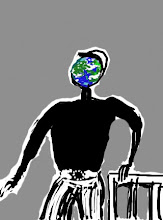Most of the world’s religions have their holy places, thought to offer closer access to the divinity. Sometimes they are associated with key events in the history of the religion concerned. They may, like Bethlehem and Mecca, have been the founder’s birthplace, or, like Jerusalem and Lourdes, the scene of apparitions, martyrdoms or miracles. Mount Ararat in Turkey is sacred to the Armenians because it is where Noah’s Ark came to rest. Mount Kailas in Tibet is venerated by Hindus as the paradise of the god Siva, and by Buddhists as the centre of the cosmos. Even when they lack any historical associations, natural features can take on religious significance, particularly if they are intrinsically mysterious and awe-inspiring. Ayers Rock, that giant monolith, is spiritually important to Aborigines, just as the symmetrical, snow-capped cone of Mount Fuji is sacred to the Japanese. Rivers and springs with healing qualities can become objects of worship. Caves and grottoes may be associated with deities and credited with prognosticatory powers. Other holy spaces are built by human hands. Churches, mosques and temples assume a numinous quality when they are seen as places where, as T.S. Eliot put it, prayer has been valid. Often containing relics and other holy objects, they are sites where wonder-working rituals may be performed. Their interior space is frequently differentiated, with some parts more sanctified than others; access for women may be restricted and entry to the holiest areas confined to the priesthood.Christianity, initially, was different: 'the early Christians were encouraged to see themselves, not buildings or sanctuaries, as the temple of the living God' (II Corinthians 6.16). For them, God was ubiquitous, rather than located in some particular spot. Only in the fourth century did Christians begin to construct their own sacred topography.' This is one background to the Reformation. In the Middle Ages 'the landscaoe was dotted with thousands of churches, chapels and monasteries; their dedications to Christ, the Virgin or the saints were often incorporated into the names of towns and villages. Crosses were erected by the wayside. Shrines housing the relics of saints became the object of pilgrimages by the faithful, seeking a place where their prayers would be more efficacious.' But 'this sacralised landscape was dealt a devestating blow by the Protestant Reformation. Like the earlier Christians, the Reformers attacked the very notion of the immancence of the holy ... one place was as holy as another, prayer was as efficacious in a field as in a church.'
At this point I want to leap, knight's--move-wise, away from the review and the book it analyses, to think about atheism. Does it make sense to think that some places are 'more' atheistical than others -- that (for instance) one might feel closer to the truth of a godless universe inside the Science Museum than inside Canterbury Cathedral? Surely not. Atheism, insofar as it represents a mindframe, is Reformation-Protestant in its logic, rather than Catholic.
The questions, then, become; both how much is this a question of intellectual lineage (as if we were to argue: the Reformation was the intervention of a little bit of atheism into the larger discourses of Christian belief -- although, it's hard perhaps to think of' atheism' as a quantity that permits degrees like this), or heritage (the Reformation is associated with the Renaissance and Enlightenment, the rise of science, and therefore ...)? And: how far might the analogy be pursued?

No comments:
Post a Comment